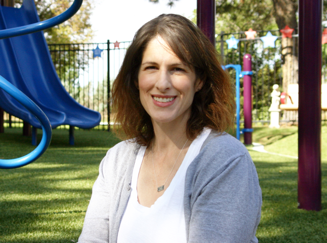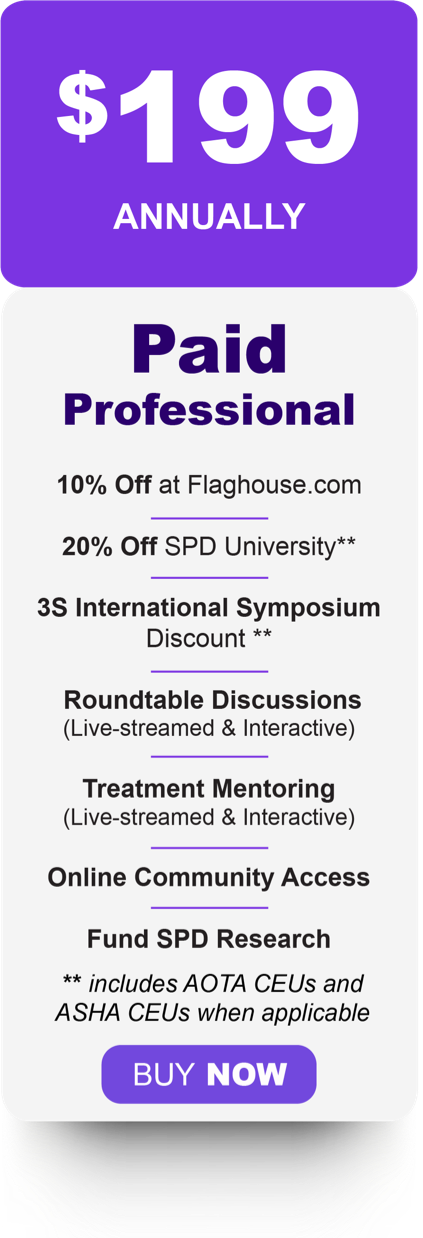
Understanding Sensory Processing Disorder (SPD) and ADHD
By Mim Ochsenbein, MSW, OTR/L

If you are a pediatric practitioner, chances are good that you have treated a child who matches the following description: impulsive, inappropriate touching of others, inappropriate and frequent movement, distractible, unaware when spoken to, difficulty following multi-step directions. Chances are also good that this client already had an existing diagnosis of ADHD, or if they did not, it was certainly on your radar of potential issues to rule out. But trying to tease apart ADHD and SPD can be very difficult. An even more difficult task is trying to explain the differences and treatment implications of those differences to a parent or teacher. In order to successfully carry out either task, the clinician must first have a firm grasp of the two diagnoses, how they differ, and what are reasonable expectations for therapeutic outcomes.
The behaviors listed above are common presentations of both ADHD and Sensory Processing Disorder (SPD). It is easy to see how a child can be mislabeled with one when they may actually be dealing with the other. Even more confusing, they may be dealing with both. They are, in fact, two separate disorders. There are certainly commonalities between the two, but there are distinct differences as well. Before looking at that, it is important to know who we are talking about.
ADHD is now a part of our pop-culture. Characters in TV, books and movies have ADHD and it is part of their story-line. Stop any person on the street and ask them about ADHD and they are likely to say they know someone who has an ADHD diagnosis. On the other hand, SPD does not garner the same recognition as ADHD. Ask that same person on the street about SPD and they may not know what you are talking. Is that because ADHD is more common than SPD? According to the Center for Disease Control, 11% of children aged 4-17 years in the United States have been diagnosed with ADHD. Statistically, if you put 100 children in a room, eleven of them will have been diagnosed with ADHD. The Center for Disease Control does not keep statistics on SPD. Fortunately, there is well regarded research that gives us an idea of how common it is. Studies indicate that 5% to 16% of children exhibit symptoms of SPD (Ahn, Miller et. al., 2004; Ben-Sasoon, Carter et. al., 2009). In that same room of 100 children, five to sixteen of them will have SPD, potentially outnumbering the children identified with ADHD, if the two groups were separate and homogenous. But they aren’t. Many of these kids have both disorders. A national stratified sample of children suggests that 40% of children with ADHD also have SPD (Ahn, Miller et. al., 2004). Back in our room of 100 children, four of the eleven ADHD identified children will ALSO have SPD.
SPD is statistically a big issue. Bigger, possibly, than ADHD. But the question remains, what is the difference? The understanding of each diagnosis can be elucidated using the perspectives of cause and treatment.
Causes: In very simple terms, ADHD and SPD are both disorders that impact the brain. Both disorders show strong signs of being largely hereditary, but pre-natal, peri-natal and environmental factors have been linked to each disorder. In ADHD, current understanding points to problems with neurotransmitters (not enough dopamine and norepinephrine) and structural abnormalities in the front part of the brain (the seat of judgment and executive functions). This directly impacts the ability to attend, focus, plan, and persist with mental challenges. People with ADHD typically display developmentally inappropriate levels of inattention, impulsivity and hyper-activity.
The causes of SPD are very different. Recent brain imaging research has demonstrated that children with SPD have abnormal white matter structure in the posterior part of the brain. White matter is responsible for carrying electrical impulses from one part of the brain to another – it’s like the highway system of the brain. The posterior parts of the brain has been identified as the location of sensory integration. For someone with SPD, the white matter in the posterior part of the brain is not effectively carrying electrical impulses. As a result, important information about the physical world is not being accurately processed. The brain with SPD is using incorrect or partial information as a basis for how it interacts in the environment. The resulting behaviors and responses are often maladaptive.
Identification: A question OTs are often asked is, “How can you tell the difference between ADHD and SPD?” It’s a fair question, given how the presentations of the disorders can look a lot alike, and the use of brain imaging is currently not a diagnostic tool. One approach is client observation following a medication trial. If the person is given ADHD medication and the behaviors improve dramatically (especially in attention, impulsivity or hyper-activity), then it is clear that the issues are at least related to an ADHD presentation. If medication is not an option, is not a preferred treatment, or there is some level of continued presentation after a successful medication trial, then we can look at other clinical observations.
ADHD is a more likely diagnosis if a person:
- Cannot stop impulsive behavior regardless of sensory input.
- Craves novelty and activity that is not necessarily related to specific sensations.
- Does not become more organized after receiving intense sensory input.
- Waits or delays gratification better when given cognitive rather than sensory inputs.
- Calms or improves attention when presented with constant novelty.
SPD is a more likely diagnosis if a person:
- Calms or focuses when provided sensory inputs.
- Becomes more dysregulated when provided novelty related to sensory input.
- Dysregulation issues seem to follow pattern (occur at a particular time of day, or during particular activities).
- Sensory sensitivities and/or craving behaviors do not seem to resolve with ADHD medication.
The tricky part is when a person has both. These are people who still demonstrate significant, functional issues even after receiving specific treatment (either for ADHD alone, or for SPD alone). Remember, studies suggest that up to 40% of children who have ADHD also have SPD. In these cases, a collaborative team approach that involves the physician, OT and mental health provider is most effective.
SPD and ADHD comorbid presentations:
- Sensory Modulation Disorder is often identified before AD/HD symptoms are apparent
- Children with AD/HD and ODD are statistically at higher risk for auditory processing issues (specifically auditory under-responsivity).
- A comorbid presentation of AD/HD and anxiety is a predictor for auditory over-responsivity.
- Children with AD/HD and ODD are more likely to have tactile over-responsivity.
- Females with AD/HD are more likely to demonstrate tactile over-responsivity.
- Generally, children with AD/HD have more difficulty with tactile processing than their neuro-typical peers, but may not be severe enough to be identified as SPD.
Treatment: It is not surprising that since ADHD and SPD cause very different issues in the brain, the approaches to treating them are also very different. Studies have shown that medication and behavioral management therapies are the most effective forms of treatment for ADHD. Medication is helpful with balancing out the insufficiencies in neurotransmitters thereby improving focus and attention. Behavioral management addresses the deficits in executive functioning, self-control and self-esteem. This is a “top-down” approach. Physicians and mental health providers who specialize in ADHD typically are the primary providers, and parents play a big role in follow through at home.
Unlike AD/HD, there is currently no medication that addresses the underlying components of SPD. Instead, SPD treatment relies heavily on a “bottom-up” approach to addressing the impacted neurological systems. Active participation of a person in a structured, sensory-rich environment by a trained occupational therapist provides them with specific, graded sensory inputs presented in meaningful and supportive activities. This kind of sensory processing therapy facilitates improved and efficient neurological responses, eventually leading to overall improved processing in the brain. Additionally, sensory strategies and sensory lifestyle components are used to support the person outside of the treatment session. Sensory-trained Occupational Therapists are typically the primary providers of this type of treatment.
ADHD and SPD may look similar at passing glance, but it is important to remember that they are two different disorders. They have different causes, effect different areas of the brain by different mechanisms, and have different evidence-based treatments. Understanding and sharing the differences between ADHD and SPD helps ensure that anyone suffering from one or both of these disorders gets the proper care they deserve.
NEW Online Courses
3235: Strategies for Arousal Regulation
Highlights the importance of understanding the “individual profile” of the child and the caregiver to support arousal regulation. Emphasis on putting the “relationship” in the forefront and “tailoring interactions” to support sensory and emotional regulation moment to moment.
More details
3104 Untangling Sensory-Processing Disorder from Autism and ADHD: Preliminary findings
Shelly J. Lane, PhD, OTR describes the importance of double gating procedures for diagnostic verification, results of physiological laboratory procedures, and preliminary report of similarities and differences in sensory symptoms across diagnostic groups. Presented at the 14th International 3S Symposium.
More details
GOAL Workshop Training
This online workshop provides step-by-step instruction for administration and scoring each item of the GOAL. It offers a structure for using intervention targets for planning and implementing treatment. In just 45-60 minutes, this assessment identifies children who may have delays in fine and gross motor skills.
More details
NEW In-person Programs
Off-site Level 1 Mentorship Program
March 15-28, 2018 • Spartanburg, SC
This 4-day version of the onsite Level 1 Mentorship program offers the same core content as the onsite program at STAR Institute. An opportunity to learn to apply clinical reasoning through lectures, video treatment observation and analysis with two experienced STAR faculty.
More details
Off-site Level 1 Mentorship Program
April 19-22, 2018 • Culver City, CA
This 4-day version of the onsite Level 1 Mentorship program offers the same core content as the onsite program at STAR Institute. An opportunity to learn to apply clinical reasoning through lectures, video treatment observation and analysis with two experienced STAR faculty.
More details
Research Mentorship Program
April 30-May 2, 3018 • Denver, CO
The 3-day Research Mentorship program is intended to help participants learn to initiate studies that can be completed over the course of the next year. Receive in-depth training from Dr. Lucy Jane Miller, Dr. Sarah Schoen, and Dr. Stephen Camarata from Vanderbilt University. Obtain support and further mentoring from us during your quarterly phone meetings.
More details
Mental Health Mentorship Program
May 17-19, 2018 • Denver, CO
A 3-day course where mental health providers develop a sensory processing lens to view behaviors associated with presenting mental health concerns. Develop critical thinking pathways for SPD recognition and a toolbox of assessment strategies and resources to use in practice for evaluation, referral and education.
More details

